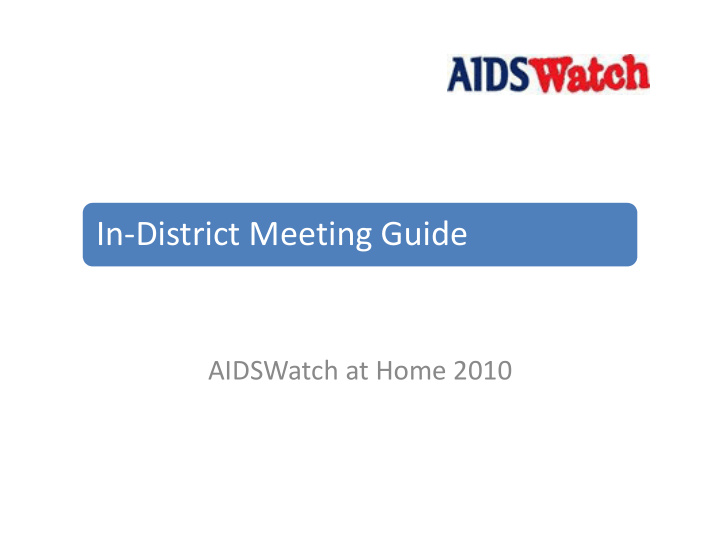



In-District Meeting Guide AIDSWatch at Home 2010
What’s in this presentation? AIDSWatch Overview In-District Meetings Finding your Members of Congress Organizing a Meeting Post-Meeting Follow-up
AIDSWatch Overview • AIDSWatch is the largest annual constituent- based federal HIV/AIDS advocacy and education event in the U.S. • Hundreds of HIV/AIDS advocates descend • Hundreds of HIV/AIDS advocates descend upon Washington, D.C. to directly lobby their Members of Congress for support of HIV/AIDS related federal policy.
AIDSWatch Overview • For every advocate able to make it to Washington, D.C. there are hundreds of advocates in their home states who can’t make the trip. who can’t make the trip. • There’s still a lot you can do from home to be a part of this nationwide effort!
In-District Meetings • Members of Congress have offices located in their home states. – U.S. Senators have offices located throughout their state – U.S. Representatives may have one or more offices in their district district • Constituents – the people who live in the area represented by the Member – can set up meetings to discuss important topics with the Member or their staff. • When these meetings take place in the Member’s home state – they’re called in-district meetings .
How to Organize an In-District Meeting Find out Who Find out Who Find Partners Find Partners Make Your Make Your Represents and Get Visit and You Organized Follow-up
Finding Your Member of Congress Every Citizen has three Members of Congress* Before you can set up a meeting, you need to meeting, you need to One U.S. know who represents Representative you in Congress. Two U.S. Senators *Note: residents of Washington, D.C. and U.S. territories are represented by non-voting delegates
Finding your Member of Congress is…
1. Go to VoteSmart.org
2. Enter your Zip Code
You May Have to Add Your 9-digit Zip, which you can find on the U.S. Postal Service website…
3. Meet Your Members!
Click on an Official’s Name to Find Their Contact Info
Organizing a Meeting At this stage you’ll have to think about: Finding other advocates Finding other advocates Scheduling the meeting Preparing your talking points Practice delivering them!
Finding Other Advocates Someone in your state or district may already be organizing in-district meetings for AIDSWatch. meetings for AIDSWatch. You can find out who they are at napwa.org
What if no one in my area is organizing a meeting? Try reaching out to these groups: AIDS Service Organizations HIV Prevention and Care Planning Councils Local Health Departments Human Service Agencies Churches
Scheduling the Meeting • Using the contact info from VoteSmart, find the fax number Fax for the district office you plan to visit • Write a letter requesting a meeting and fax it to the office • Use the sample provided in this toolkit • After faxing, call the office and ask to speak to the Call scheduler • You may have to call several times and may only be able to set up a time to meet with staffers (that’s ok!) Confirm • After you set up the meeting time, you should call the office again the week of the meeting to confirm the appointment
Sample Meeting Request Letter Key Points: Date Recipient’s Address Recipient’s Address Recipient’s Fax Number Message with Request
Preparing Your Talking Points Policy Asks Personal Story • Review the AIDSWatch • Use the Tell Your Story factsheets at napwa.org Worksheet to get on the following topics: on the following topics: organized. Available at organized. Available at napwa.org. • Health Care Implementation • Make the connection between the issues and • National HIV/AIDS your personal story Strategy • Tell how your life has • Appropriations been affected
Practice Delivering Your Talking Points • If you are making the visit with a group of advocates, divide the topics among the group and practice delivering them together. • If you are on your own, find • If you are on your own, find a friend to stand-in as the legislator to help you rehearse. • REMEMBER: Tell your story and DON’T FORGET TO MAKE THE POLICY ASK!
Make Your Visit and Follow-Up Meeting Day Checklist: • Dress professionally • Bring copies of factsheets • Arrive 15 minutes early • Be polite and courteous • Be polite and courteous • Take note of any questions or requests for additional information • Remember to thank the Congressperson or staffer for their time • Tell them you will follow-up
Don’t Forget to Follow-Up! • At the end of your meeting, tell the Congressperson or staffer that you will follow up with them soon • Send a thank you card to reiterate your ask and show reiterate your ask and show your appreciation • Send them the additional information they requested and/or answers to their questions • Keep track of their support or opposition to your asks and call or write to say thank you or to keep pushing them
File a Visit Report to Help Track our Progress • After your visit, take 5 minutes to fill out an online visit report available here: • This is to help us keep track of which Members of Congress have been reached and what messages they’ve received.
Questions? Contact: Jim Merrell Jim Merrell AIDS Foundation of Chicago 312-784-9048 jmerrell@aidschicago.org
Recommend
More recommend